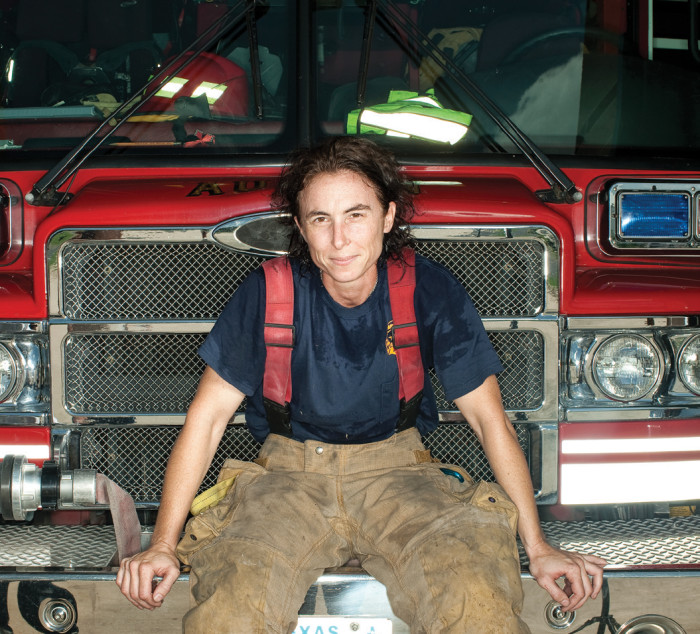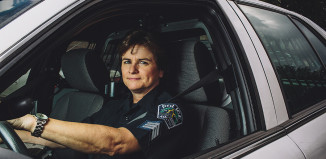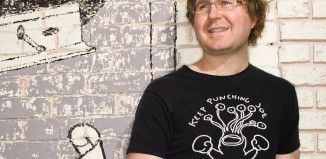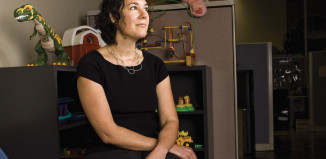The alarm goes off. Whether sound asleep or wide awake, Austin firefighter Kat Casey springs into action. With only minutes to put on 50 pounds worth of gear and head out, she has no idea what she might face. A fender bender can become a massive, fiery wreck with trapped passengers. A little static in a house with a natural gas leak can trigger an explosion. The fire can curl up and cause the ceiling to collapse in on her. No matter what she finds herself facing, Casey does it all with aplomb.
“The main thing is helping people,” said Casey, firefighter at station 35 on Burleson road in south Austin. “With some calls, you need to have patience; some need endurance. Whatever it is, you’re there to help people.”
 Casey’s soft-spoken and matter-of-fact demeanor doesn’t in any way diminish the intensity of her job and how she approaches it. Her pride was evident as she discussed her experience as a female (and openly gay) firefighter and the demanding aspects of her job while sharing war stories of noteworthy fire calls over coffee. Perfectly at ease giving us the full tour of her station–and thrilled for us to try on her gear–Casey’s journey to this moment hasn’t been straightforward.
Casey’s soft-spoken and matter-of-fact demeanor doesn’t in any way diminish the intensity of her job and how she approaches it. Her pride was evident as she discussed her experience as a female (and openly gay) firefighter and the demanding aspects of her job while sharing war stories of noteworthy fire calls over coffee. Perfectly at ease giving us the full tour of her station–and thrilled for us to try on her gear–Casey’s journey to this moment hasn’t been straightforward.
Applicants must pass both a written test and a physical test in order to qualify for employment as a firefighter. The first time she took the test, her scores weren’t high enough; the second time, the class she’d applied for was canceled; the third time, everything worked out. She said it was a little intimidating to be in a room with 3,500 people applying for a total of 60 openings. The physical test requires that applicants do all the physical motions of a firefighter, many times over, to test their stamina. Even so, Casey, who worked for the crime scene division of the Austin Police department prior to becoming a firefighter, described firefighting as the perfect fit for her abilities and interests. “It’s hands down the coolest thing,” Casey said. “In the crime scene division, we dealt solely with the evidence. I’m a really physical person, and I have a lot of energy. This is a hybrid; it involves problem solving, it’s physical and you’re helping people.”
Casey, a native of Austin and an only child, said she always knew that she wanted to work in a profession that would allow her to give back and help others. For a time, she thought maybe medical school was where life would take her. She’d never seen a female firefighter until she moved back to Austin from Dallas, where she had been working in the office of an HIV specialist.
She characterized the Austin Fire Department (AFD) as accepting and said her sexual orientation–which she’s open about as a member of FireFLaG, the gay affiliate group of the Austin Fire Department–has never been an issue. The AFD has several organizations for firefighters in minority groups, such as Hispanic firefighters, black firefighters and others. Since women are a minority in the fire service to begin with, finding other lesbian colleagues was not difficult for her. When she first started, coworkers would ask, “Where did you come out?”
“I kept thinking, ‘all these guys are gay, no way!’” She laughed at the memory of learning the lingo. They were asking which station she first worked at.
Heeding The Call
You’ve gotta be tough to fight fires. “You’re wearing an oven mitt and you have a giant air-pack and helmet on and it’s about as hot as it gets,” said Casey, noting that her gear weighs more than 70 pounds when tools and hoses are factored in. “You can’t dissipate any heat and it’s more taxing than you think.”
It’s not a schedule for the faint of heart. Firefighters work for 24 hours and have 48 hours off; each shift starts at noon but firefighters arrive at 11:30 a.m. When the alarm, or the tone, as Casey called it, does not go off, there’s down time for training, working out and continuing education. “a fire is a real specific tone that comes over the speaker and you get an adrenaline dump,” said Casey, in her fourth year with the department. “I have insomnia anyway. When I first started, I didn’t sleep for a few weeks because I was laying in bed waiting for the tone to go off.”
One call that stands out in her memory was a natural gas leak at a new subdivision. When the firefighters opened the front door, the odor enveloped them. They were given an order to ventilate the house, so they opened the windows on both floors. “We use devices to measure the concentration of the gas,” Casey said. “We came back downstairs and the guy who’d given us the order got real upset. He’s like, ‘you could have died.’” as it turned out, the concentration of gas was much higher upstairs and since they were walking on the carpet, anything (a little static, even) could have sparked an explosion. “That made me realize there’s so much I don’t know,” she said, remarkably calm as she retold the story. “There was no finger pointing. It was, what are we going to do better next time?”
Casey’s fifth shift driving the truck happened to be the fire at the governor’s mansion downtown; they got to Enfield and North Lamar and could smell the smoke. They threw a ladder up and went inside to try to locate the source of the fire; sometimes the only way to access it is through the ceiling. “I looked up and there was fire rolling above us between the floor and the ceiling,” Casey said. “Shortly after that, we took a different tactic: We went defensive and sprayed more water on it from the outside.”
Casey described how the intensity of the job, combined with the ongoing adrenaline rush, can cause people to compartmentalize emotional reactions. Her very first shift involved a call about a rollover accident. It ended up being a horrible wreck, according to Casey, and they were only able to save one of the two people in the car. “You’re trying to focus on the one person who you can help and the other person is screaming for you,” Casey said. “At the time, you don’t have all the emotions about it. You do what you need to do and deal with it later.”
Typically, AFD firefighters rotate among Austin’s 44 stations every third or fourth shift as part of their schedule. Each location is completely different. Some stations are small, old-style firehouses, while others–such as Casey’s–are quite large. Living together means understanding the protocol of the mundane aspects of life. The firefighters don’t always necessarily eat together, but asking what’s for dinner is a major faux pas. “You can be on the wagon or not,” Casey said. “That’s what they call food. Are you on it or not?” the food served at Casey’s station is pretty healthy, with several colleagues favoring the Engine 2 Diet, a low-cholesterol, plant-based program developed by local firefighter Rip Esselstyn. Of course, Casey admitted that there are times when the meal might be more stereotypical firehouse fare, such as “steak with bacon grease.”
 Even when her adrenaline is pumping and everyone is frantic or nervous, Casey said that her fire chief and captain are a calming presence in the midst of the storm. “My captain and chief are so cool,” she said. “It’s so wonderful to work with them because you’re pumped up and everything is going on, but you have these calming presences.”
Even when her adrenaline is pumping and everyone is frantic or nervous, Casey said that her fire chief and captain are a calming presence in the midst of the storm. “My captain and chief are so cool,” she said. “It’s so wonderful to work with them because you’re pumped up and everything is going on, but you have these calming presences.”
In The Zone
A self-described “total tomboy” growing up in North Austin, Casey has always loved physical activity. She ran track in high school, played rugby for a bit in her early twenties, likes to run in McKinney Falls State Park and enjoys mountain biking as well.
Although she knew she was gay as a teenager, Casey traces self-awareness of her sexuality back to her crush as a 6-year-old on Olivia Newton-John in Grease. Out to most of her friends in high school, she didn’t get much flak for being gay. Even though she didn’t want to have the conversation with her parents at first, it eventually just clicked and they got it. “My parents couldn’t be any cooler about it,” she said. “They love my girlfriend and my friends and I feel fortunate for that.”
She may have had it relatively easy, but Casey insisted that things have changed a lot since then. Culturally, she’s certainly right. As a young female, she didn’t have cultural touchstones like The L Word, Rachel Maddow or even Ellen DeGeneres, to ease her way out of the closet but that didn’t prevent her from connecting with her girlfriend of three years, Lyndsey Norman.
“When she tells it, it’s much more interesting,” Casey laughed, referring to how she met Norman. They met at Pride five years ago but didn’t begin dating right away. Norman was attending the celebration with friends and Casey was dating someone else at the time. “She didn’t give me the time of day and I was trying to be all nice and charming,” said Casey. “The way she tells the story is that she met me and she was intimidated by me.”
Norman has been a child advocacy specialist for Court Appointed Special Advocate (CASA) for children in Travis County for about three and a half years. CASA’s mission is to help children who have been abused, who live in homes where parental drug abuse is an issue, or who were removed from abusive homes. “It’s totally intense,” Casey said. “I couldn’t do an hour of what she does; she’s got the patience of a saint.”
“When we got together, I was already a firefighter,” Casey said, noting that sometimes relationships can buckle under the strain of the atypical schedule. “It works well for both of us. She comes to the fire station fairly often with homemade cinnamon rolls and the guys love her.”
“I am extremely proud of her profession,” Norman said. “Being a firefighter takes a lot of bravery, strength and commitment and she does it all with a lot of enthusiasm and style. Early on, I tended to worry about her safety, but I worry less now. She’s smart and capable and part of a very competent and experienced team of firefighters.”
They have date nights where Norman cooks dinner and the couple watches a movie or they’ll ride their bicycles around town and people watch over gelato. “We have a lot of fun together and spend a lot of our free time together,” Norman said, “but are also respectful of each other’s need for alone time.”
Although having children is something they’ve discussed, and it interests them both, for now they are simply enjoying life. “She’s been a huge help to my efforts to get in shape–and I do have to say that I’m currently winning our contest to see who can log 50 miles first [running],” Norman said.
The couple lives near Springdale and 12th street, where they found a cool lot with two houses. The second house, in the back, is their self-styled swanky 1970s den, complete with wood paneling and a faux fireplace. It’s where they host parties, and they’ve gone with the 70s theme.
Raised Catholic but disillusioned with the church in later years, Casey and Norman recently started attending St. David’s Episcopal Church downtown; both are in the midst of strengthening their connections to church and community. “I don’t know what was cooler about the Pride Parade, that I got to be on the fire truck or that I got to see everyone from my church there,” Casey said.
Energy & Passion
Casey graduated from UT in 1995 with a Bachelor of Arts degree, focusing on printmaking and photography. After living in a cabin and working on her dad’s cattle ranch for a summer, she held a few odd jobs before moving to Dallas. From time to time, Casey and a group of female firefighter friends will head out to Johnson City and round up calves on her ranch. He’s been a full-time cattle rancher for 20 years, and the ranch has been in the family since the 1850s.
 Beyond her daily appreciation for what she does, Casey’s graduation from the fire academy* was one of her proudest moments, and it prompted her to return to the academy to be a team leader for six months, teaching students. “I had my dad put my badge on me when I got it,” Casey said, noting the significance of having her father pin the badge on her. “That was awesome.”
Beyond her daily appreciation for what she does, Casey’s graduation from the fire academy* was one of her proudest moments, and it prompted her to return to the academy to be a team leader for six months, teaching students. “I had my dad put my badge on me when I got it,” Casey said, noting the significance of having her father pin the badge on her. “That was awesome.”
Her father, who’s been married to her mother for 42 years, stayed at Casey and Norman’s house for a month following surgery for mouth cancer in June. The 10-hour operation, which involved partially reconstructing his face with bone and tissue from elsewhere in his body, took an emotional toll on Casey, who is close to him. “My mom was fine when she came back after seeing him, but I lost it,” she admitted. “I’ve seen way worse, but when it’s your family, it’s pretty intense.”
Beyond her connection to family and friends, Casey draws energy and inspiration from being physical. Whether she’s mountain biking or out on a fire call or running around the park, it puts her in a zone where she can be centered. “Part of that is doing something that requires all of that concentration or something that’s so physically demanding that you can’t do anything else,” Casey said. “I like to do that to myself a lot; I’m kind of a masochist. I think it’s because I have so much energy. If I exhaust myself, I can feel more grounded and focused.”
While her mission with the AFD provides much of the meaning in her life, Casey is also proud to ride the truck each year for another important mission, representing the fire department and the LGBT community during the Pride Parade, something she said she will always do. And when she’s awaiting a call at the firehouse, Casey said she can be found unabashedly geeking out, poring over firefighting trade publications. And she says she couldn’t be happier. “I couldn’t imagine not doing what I’m doing now.”




































